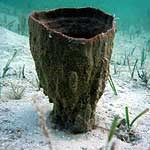
NPS image by Matt Johnson A vast expanse awaits. It extends from the mangrove shoreline and over Biscayne Bay. With the wide blue sky above and gin clear waters below, you seem suspended in time and space. Biscayne Bay is a shallow estuary. It is a place where freshwater from the mainland mixes with salt water from the sea. The bay serves as a nursery for marine life. Lush seagrass beds provide hiding places as well as food for a vast array of sea life. Many fish, crustaceans and shellfish spend a portion of their lives in the protective environment of the bay. The bay is one of the most productive ecosystems in the park. Fresh water flow brings nutrients from inland areas. Plants combine these nutrients with energy from the sun, carbon dioxide and water to produce food. Beneath the clear water of the bay are two primary ecosystems; hardbottom and seagrass communities. 
Hardbottom community - Sediment is thin here and plants cannot take root. Although these areas may seem barren and lifeless, this is far from the truth. They are home to soft corals, sponges and numerous invertebrates that find shelter in the sponges or beneath the thin layer of sediment. This life includes tasty spiny lobsters that find food and shelter here. 
Seagrass meadows - Where bay bottom sediment is more than a few inches thick, lush seagrass meadows form. Like neighborhood lawns, seagrasses are flowering plants. They have roots, stems and flowers. They produce oxygen. Without exceptionally clear water to allow sunlight through, seagrasses die. This is just as neighborhood lawns do when deprived of sunlight. There are three major types of seagrasses found in the bay. Shoal grass (Halodule wrightii) is an early colonizer of disturbed areas and usually grows in water too shallow for other species. Turtlegrass (Thalassia testudinum), the most common seagrass in the park, has wide leaf blades and a deep root structure. It forms most of the large, lush seagrass meadows of the park. Manatee grass (Syringodium filiforme) is easily recognizable because its leaves are cylindrical. |
Last updated: February 21, 2017
